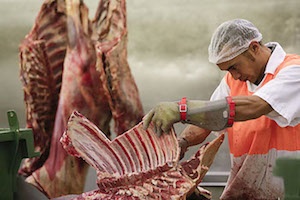The Ministry of Agriculture predicted a decrease in meat prices in Russia

In RUSSIA, the rise in MEAT prices is due to a seasonal factor, and their decline is expected at the end of August, said Minister of Agriculture Dmitry Patrushev.
“Given the increase in production, I think that in the near future we will see a decrease in prices. I think that this will happen in late August - early September, and prices will stabilize," he said.
The Ministry of Agriculture did not see the prerequisites for a shortage of meat or a further increase in its cost. The situation on the market is calm, and production volumes are growing, Patrushev assured.
Thus, the country produced 7.6 million tons of livestock and poultry for slaughter, which is 2.6% more compared to the same period last year. In Russia, self-sufficiency in meat according to the results of last year exceeds 100%, the minister concluded.
According to Rosstat, in the first half of 2023, Russia produced 1.8 million tons of meat ( cattle , pork, lamb, etc.). The production of poultry meat and by-products amounted to 2.5 million tons.
Earlier, according to the results of June, the cost of a kilogram of chilled and frozen chicken meat increased by 6.8% - up to 193.48 rubles, followed from the data of the Unified Interdepartmental Information and Statistical System.
Read PIONERPRODUKT .by How to identify the most influential leaders in a team — Quartz Jester or sage: how to create a bright brand character Russia has entered into a DTA with Oman. What taxes do not have to pay twice Maybe I have autism: how adults are diagnosed todayFORBES , citing analysts from Emeat, announced an even greater increase in retail prices for chicken meat - up to 270 rubles. per kg. In this case, the cost range can be from 200 to 350 rubles.
Vedomosti, citing price index data from the analytical agency AD Libitum, reported on August 4 that prices for commercial pork had increased by 7% since the beginning of this week, to 148 rubles. per kg, which is 20% higher than in the same period last year.
Then the Ministry of Agriculture announced that the Russian market was fully provided with pork, and explained the increase in the cost of meat as a seasonal factor and an increase in demand.
Read together with it:
- In the Saratov region, the court upheld the decision of the Rosselkhoznadzor Office to prosecute a farmer for violating veterinary rulesThe supervisory authority issued an order to the farmer to eliminate the violations. However, at the time of the inspection to monitor the implementation of the order, the farm had not organized disinfection of vehicles, work clothes and shoes in which animals were cared for. There was no heat treatment of the MILK before feeding it to the calves. The farm also did not carry out deratization and d...
- Годовая инфляция в России ускорилась до 6,59%С начала октября инфляция составила 0,69%, с начала года — 5,39%. В сегменте продовольственных товаров за неделю цены выросли на 0,39%, стоимость овощей и фруктов увеличилась на 1,15%. Помидоры подорожали на 7,3%, огурцы — на 3,7%. В сегменте непродовольственных товаров с 17 по 23 октября инфляция примерно на уровне предыдущей недели — ......
- Минсельхоз заявил о продолжении выдачи льготных кредитов аграриям"Несмотря на повышение ключевой ставки, выдача льготных кредитов у нас продолжается", - сказал Дмитрий Патрушев. "На это дополнительно выделено 55 млрд рублей, что в том числе позволило нам на 35% увеличить лимит по так называемым коротким кредитам", - добавил он.
- Бразилия: в Санта-Катарине наблюдается рост экспорта свининыОбщая стоимость экспорта свинины и курицы из Санта-Катарины, как свежей, так и переработанной, за первые девять месяцев 2023 года достигла 2,95 миллиарда долларов США. Цифры были опубликованы Министерством экономики и проанализированы Центром социально-экономики и сельскохозяйственного планирования (Epagri/Cepa). С января по сентябрь штат экспортировал 491,7 тыс. тонн свинины, а выручка составила ...
- Australia wants better access to beef and sugar as part of EU trade dealFarrell also said that the EU had advocated low quotas for Australia, saying its agricultural productshave taken market share from EU manufacturers inUK following the conclusion of an Australia-UK trade deal in 2021. a> Both sides have been negotiating since 2018. Farrell will meet EU Trade Commissioner Valdis Dombrovskis at the G7 trade ministers' meeting in Japan on October 28-29. He warned that...
- Китай запрещает ввоз жвачных животных из Бельгии и НидерландовТаможня Китая запретила импорт жвачных животных и продуктов из Бельгии и Нидерландов после вспышки болезни блютанг, сообщает REUTERS. Голландские фермеры уже больше месяца борются со вспышкой блютанга. В начале октября заражению подверглись около 600 ферм. Вакцины против нынешнего штамма блютанга не существует. Вспышки, вероятно, будут продолжать ограничивать экспорт коров и овец из обеих стран......



























































